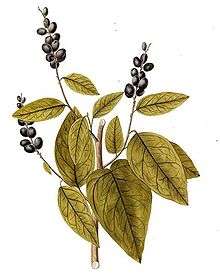Coccoloba diversifolia
| Coccoloba diversifolia | |
|---|---|
 | |
| Scientific classification | |
| Kingdom: | Plantae |
| (unranked): | Angiosperms |
| (unranked): | Eudicots |
| (unranked): | Core eudicots |
| Order: | Caryophyllales |
| Family: | Polygonaceae |
| Genus: | Coccoloba |
| Species: | C. diversifolia |
| Binomial name | |
| Coccoloba diversifolia Jacq. | |
| Wikimedia Commons has media related to Coccoloba diversifolia. |
Coccoloba diversifolia, commonly known as pigeonplum, doveplum, pigeon Seagrape or tietongue, is a species of the genus Coccoloba native to coastal areas of the Caribbean, Central America (Belize, Guatemala), southern Mexico, southern Florida (coastal regions from Cape Canaveral to the Florida Keys) and The Bahamas.[1][2][3]
Description
Coccoloba diversifolia is a small to medium-sized tree growing to 10 m (rarely to 18 m) tall. The bark is light gray, smooth, and thin but may become scaly on the largest trees. The leaves are 3–13 cm long and 1–7 cm broad, smooth edged, wavy, oval to oblong, rounded or pointed on the ends, leathery, brighter green above and paler below; leaves on young plants and root sprouts are larger than those on mature plants.
The flowers numerous inconspicuous appear on spikes 1.5–18 cm long in the spring. The fruit is an achene 6–10 mm long surrounded by a dark purple edible fleshy perianth, ripening in the fall. The tree is unable to survive hard frost. It is resistant to high winds, salt and drought.[1][4][5]
See also
References
- 1 2 Flora of North America: Coccoloba diversifolia
- ↑ Germplasm Resources Information Network: Coccoloba diversifolia
- ↑ Florida Institute for Systematic Botany: Coccoloba diversifolia
- ↑ Florida Institute for Systematic Botany: Coccoloba diversifolia images
- ↑ Bush, C. S.; Morton, J. F. (1969). Native Trees and Plants for Florida Landscaping. Florida Department of Agriculture. pp. 35–36.